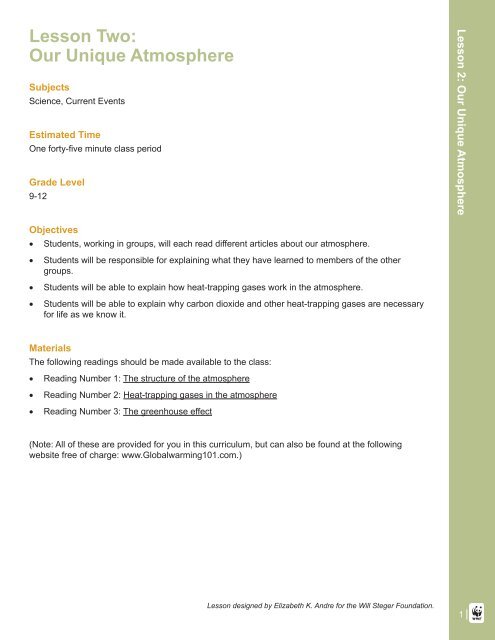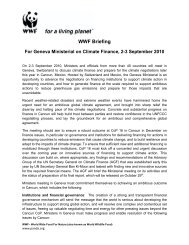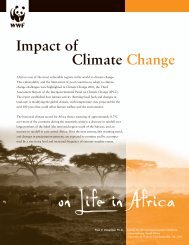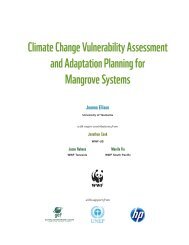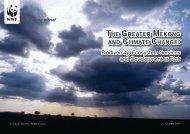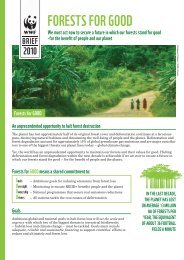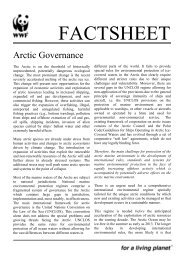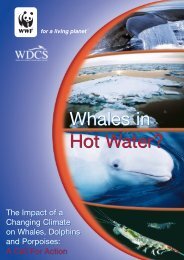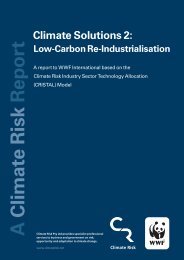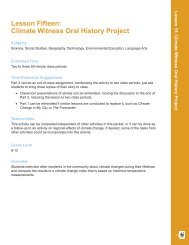Lesson Two: Our Unique Atmosphere - WWF Blogs
Lesson Two: Our Unique Atmosphere - WWF Blogs
Lesson Two: Our Unique Atmosphere - WWF Blogs
You also want an ePaper? Increase the reach of your titles
YUMPU automatically turns print PDFs into web optimized ePapers that Google loves.
<strong>Lesson</strong> <strong>Two</strong>:<strong>Our</strong> <strong>Unique</strong> <strong>Atmosphere</strong>SubjectsScience, Current EventsEstimated TimeOne forty-five minute class periodGrade Level9-12<strong>Lesson</strong> 2: <strong>Our</strong> <strong>Unique</strong> <strong>Atmosphere</strong>Objectives• Students, working in groups, will each read different articles about our atmosphere.• Students will be responsible for explaining what they have learned to members of the othergroups.• Students will be able to explain how heat-trapping gases work in the atmosphere.• Students will be able to explain why carbon dioxide and other heat-trapping gases are necessaryfor life as we know it.MaterialsThe following readings should be made available to the class:• Reading Number 1: The structure of the atmosphere• Reading Number 2: Heat-trapping gases in the atmosphere• Reading Number 3: The greenhouse effect(Note: All of these are provided for you in this curriculum, but can also be found at the followingwebsite free of charge: www.Globalwarming101.com.)<strong>Lesson</strong> designed by Elizabeth K. Andre for the Will Steger Foundation.
<strong>Our</strong> <strong>Unique</strong> <strong>Atmosphere</strong>How does our atmosphere keep the earth warm?ProcedureHave students count off from one to three. Each student must then find another student who has thesame number. For example, a student with the number one would find another student who is also anumber one. In these pairs, the students cooperatively read the following passages:Reading Number 1: The structure of the <strong>Atmosphere</strong>Reading Number 2: Heat-trapping gases in the atmosphereReading Number 3: The greenhouse effect (10 min)Each pair then plans a way to teach their topic to other students. Their lesson will need to include anexplanation of the major concepts in the passage and an explanation of the visuals that accompanythe passage. Students will also need to include in their lesson an original analogy and an original visualthat help explain the concepts in their passage.Make sure students understand that an analogy is a comparison based on a similarity between twothings that are otherwise dissimilar. For example, students who read the passage about the layersof the atmosphere could compare the layers of the atmosphere to the different colored layers on agobstopper candy, an onion, or a layer cake. They would then draw a visual that helps clarify theiranalogy.These pairs then split and each student finds another student who also has the same number. Forexample, a student with the number one will find a different student who is also a number one. Thesenew pairs then share with each other the lesson they prepared with their first partner, including theanalogy and original visual. These new partners give each other feedback on aspects of their lessonthat were especially good. Each can then decide to incorporate certain aspects of the partner’s lessoninto his or her lesson to strengthen it. (5 min)Next, students find new groups that comprise a student with each number. For example, a studentwith the number one would find a student with the number two and also a student with the numberthree. Starting with the student with the number one, the students teach their lessons to the other twostudents in their group. (10 min)The teacher then picks one student from each passage to share his or her analogy and visual with theclass. (5 min)Notes to the teacher:As the students are cooperatively reading, planning and practicing their lessons and presenting theirlessons to each other, circulate between the groups and listen at each group for a few moments togauge the progress of the groups and to make certain that students are focusing their efforts on thetask.Before dividing the students into groups, explain the entire activity to them and let them know howmuch time they will have for each section of the activity.Explain to the students that you will be circulating between the groups during this activity and that youmay ask any student at any time to explain any aspect of the passages. Let them know that it is theresponsibility of each group to make sure that each group member understands all the concepts andwould be ready to explain any of the topics.
National Standards AlignmentNational Science EducationUnifying Concepts and Processes (5-12): Systems, order, and organization; Change, constancy, andmeasurementEarth and Space Science (5-12): Energy in the earth systemScience in Personal and Social Perspectives (5-12): Populations, resources, and environments;Environmental qualityEnvironmental Education Guidelines for Learning (K-12)Strand 1: Questioning and Analysis Skills: Organizing information; Working with models andsimulations; Developing explanationsStrand 2: Knowledge of Environmental Processes and Systems: Processes that shape the earth;EnergyStrand 2.2: The Living Environment: Systems and Connections<strong>Lesson</strong> 2: <strong>Our</strong> <strong>Unique</strong> <strong>Atmosphere</strong>Standards for the Language ArtsStandard 4: Students adjust their use of spoken, written, and visual language (e.g. conventions, style,vocabulary) to communicate effectively with a variety of audiences and for different purposes.Standard 12 : Students use spoken, written, and visual language to accomplish their own purposes(e.g. for learning, enjoyment, persuasion, and the exchange of information).
Reading Number 1:The structure of the <strong>Atmosphere</strong>The atmosphere is about 372 miles (600 kilometers)thick. While this may seem like a lot, when comparedto the size of the earth, the atmosphere is a relativelythin layer of gases. In the photo to the right you cansee how relatively thin the atmosphere is.Based on temperature, the atmosphere is dividedinto four layers. The layer closest to earth’s surfaceis the troposphere. The troposphere is thickest inthe tropics (about 9 miles/14.5 kilometers thick) andthinnest at the poles (about 5 miles/8 kilometersthick). Most weather happens in the troposphere.The troposphere is the densest of all the layers ofthe atmosphere and it contains about 80% of themass of the atmosphere and almost all of the waterin the atmosphere. The average temperature in thetroposphere is highest at ground level and decreases to about negative 57 degrees F (-52 degrees C)in the uppermost parts of the troposphere.At the very top of the troposphere is the tropopause. This layer is very stable and separates thetroposphere from the next layer, the stratosphere. Have you ever seen a thunderhead (cumulonimbuscloud) with a flat top? Sometimes this flat top is caused by winds, but sometimes it is caused by the topof the cloud reaching the tropopause and not being able to go up any further.Together, the troposphere and the tropopause are known as the lower atmosphere. It is in the loweratmosphere that heat-trapping gases (some people refer to these as greenhouse gases) accumulate.Source: globalwarming101.comAbove the tropopause isthe stratosphere and themesosphere. Together theyare known as the middleatmosphere. Chemicalsin the middle atmosphereabsorb and scatter theultraviolet radiation coming infrom the sun.Above the middleatmosphere is thethermosphere or upperatmosphere. Temperaturesincrease the higher yougo up in the thermospherebecause of the incomingenergy from the sun.Temperatures can reachover 3,140 degrees F (1,700degrees C).Study the graph to the left.The red line represents theaverage temperature.© NASA
Reading Number 2:Heat-trapping gases in the atmosphereHeat-trapping gases collect in the troposphere and include carbon dioxide (CO2), nitrousoxide (N20), methane (CH4), water vapor (H20), ozone (O3), and chlorofluorocarbons (CFCs).These gases act like a blanket in the atmosphere, trapping heat and warming the planet.Some scientists have also called these gases “greenhouse” gases, because akin to an actualgreenhouse made of glass and used to grow plants when it is too cold outside, these gases trapheat and help regulate the temperature on earth.Air is made up of different gases, and gases are made up of molecules (which are, in turn, madeup of atoms). These molecules are so small that they cannot be seen with the naked eye andthere is a lot of space between individual molecules; that is why air is transparent.Based on the structure of the molecules, some gases are more effective at trapping heat thanothers and stay in the atmosphere for longer. The better a gas is at trapping heat and the longerit stays in the atmosphere, the more potential it has for aiding global warming (we will learnmore about how this works in the next lesson).We use the global warming potential of carbon dioxide (CO2) as a standard against which wecan compare other trace gases. To make comparisons easily, we label carbon dioxide (CO2)as having a Global Warming Potential (GWP) of 1. We can compare this to other greenhousegases. Methane (CH4) has a GWP of 23 (measured over a 100 year period). Other gases havemuch longer atmospheric residence times, like sulfur hexafluoride which has a GWP of 22,000over 100 years. We don’t hear much about hexafluoride, however, because it has very lowconcentrations in the atmosphere.One heat-trapping gas that has a low GWP because its atmospheric residence time is onlya few days is water vapor (H2O). Even though it has a low GWP, there is a lot of it in theatmosphere at any given time. Water vapor is the most common heat-trapping gas.As we learn more about the greenhouse effect and global warming, we will be hearing a lotmore about carbon dioxide and methane. Both of these gases have a big impact on how muchheat is trapped in the lower atmosphere.The concentration of gases in the atmosphere is measured in parts per million (ppm), partsper billion (ppb) or parts per trillion (ppt). For reference, concentrations of carbon dioxide arecurrently about 380 ppm and concentrations of methane are about 1,800 ppt.<strong>Lesson</strong> 2: <strong>Our</strong> <strong>Unique</strong> <strong>Atmosphere</strong>
Reading Number 3:The greenhouse effectHave you ever noticed that on a sunny day, the temperature is much higher inside of your carthan it is outside when your car has been parked in the sun with the windows rolled up? Orhave you ever gone inside of a greenhouse where plants are grown in the winter months andnoticed that the temperature is much higher inside than it is outside? If you have, then you’veexperienced a greenhouse effect. The earth has a layer of gases that, although not a perfectanalogy, act like the layer of glass on a greenhouse or in your car and trap heat that wouldotherwise be lost to space. The way it works is that energy, in the form of light and heat, comesfrom the sun. That energy is either reflected by the earth or absorbed and then re-radiated backtowards space. When this out-going energy hits the layer of heat-trapping gases, some of itpasses through back out into space, but some of it gets trapped and re-reflected back to earth.This keeps the temperature on Earth warmer than the temperature in space.
<strong>Lesson</strong> 2: <strong>Our</strong> <strong>Unique</strong> <strong>Atmosphere</strong>The atmosphere and this heat-trapping effect make life as we know it possible on earth. Without theheat-trapping gases in our atmosphere, temperatures on earth would average around 0 degreesF (-18 degrees C) and the surface of the earth would be frozen. Without an atmosphere, thetemperatures on the earth would be more like they are on the moon. Because the moon doesn’thave the atmosphere acting like a blanket, insulating the moon from the sun on the side that facesthe sun and trapping heat on the dark side of the moon, temperatures vary dramatically betweenthe side of the moon that faces the sun and the dark side of the moon. In fact on the side of themoon that faces the sun, the temperatures can reach 260 degrees F (water boils at 212 degrees F).On the dark side of the moon, it can get as cold as -280 degrees F.On the earth there is a difference in temperature between the day and the night (this is calleddiurnal variation), but it is nowhere near the difference in temperatures experienced on the moonbetween the light side and the dark side. This is because of our atmosphere and our heat-trappinggases.If a planet has a lot more heat-trapping gases, the temperature would be much hotter. For example,Venus has a much higher concentration of heat-trapping gases, and temperatures on the surfaceare above 350 degrees F (177 C). That is hot enough to melt lead!


